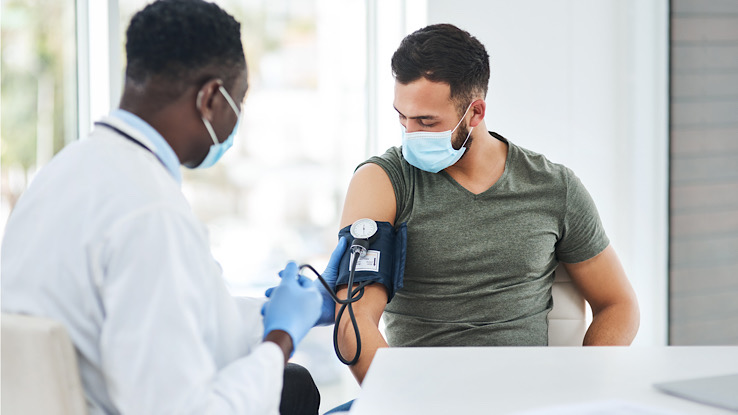
Hypertension is characterized by high blood pressure, and it’s an important risk factor for heart disease. It’s a modifiable risk factor, which means you can make lifestyle changes to lower your blood pressure and improve your health. People may be unaware that they have high blood pressure because the symptoms don’t develop until late in the disease course. This is why hypertension is sometimes called “the silent killer.” So, it’s important to have regular check-ups with your doctor and get screening for your risk of hypertension. Here’s what you need to know about blood pressure readings.
Blood Pressure Basics
Your blood pressure is regulated by a complex system that involves your blood vessels, heart, kidneys, lungs, brain, and immune system. Blood pressure readings show as a fraction and consist of two numbers in milligrams of mercury (mmHg).
- Systolic blood pressure (SBP) is the upper number. SBP corresponds to when the heart is pumping and represents the maximal pressure of blood against the artery walls.
- Diastolic blood pressure (DBP) is the lower number. DBP is the pressure of blood against the vessel walls when the heart is relaxing.
What Are Normal Blood Pressure Readings?
Normally the SBP should be between 90 mmHg and 120 mmHg. Your doctor will advise you to keep your SBP below 120mmHg. However, if it drops below 90 mmHg, it can be a sign of severe illness, and you should seek medical attention.
Normal DBP should be between 60 mmHg and 80 mmHg. Therefore, normal blood pressure is 120/80 mmHg. These are the normal values for adults; for children, normal blood pressure will depend on age, sex, and weight. For the list of children’s normal blood pressures, see the NIH Pocket Guide.
What are Elevated Blood Pressure Readings?
Hypertension is any elevated blood pressure readings above 120/80mmHg, and it can be broken down into four different levels.
Elevated blood pressure: when your SBP is 120-129 mmHg, and your DBP is below 80mmHg.
- Systolic Blood Pressure: 120-129 mmHg
- Diastolic Blood Pressure: <80 mmHg
Hypertension stage 1: when your SBP is 130-139 mmHg or your DBP is 80-89mmHg.
- Systolic Blood Pressure: 130-139 mmHg
- Diastolic Blood Pressure: 80-89 mmHg
Hypertension stage 2: when your SBP is higher than 140 mmHg or your DBP is above 90 mmHg.
- Systolic Blood Pressure: >140 mmHg
- Diastolic Blood Pressure: >90 mmHg
Hypertensive crisis: when your SBP is higher than 180 mmHg and/or your DBP is above 120 mmHg. Please get immediate medical attention.
- Systolic Blood Pressure: >180 mmHg
- Diastolic Blood Pressure: >120mmHg
Interpreting your blood pressure can be tricky, and you should always consult your doctor to understand what it means for you. In general, one elevated blood pressure measurement is not especially concerning on its own unless it’s very elevated because a number of factors can influence blood pressure. It is more concerning if you have multiple repeated blood pressure measurements above target.
Causes of High Blood Pressure

Many factors contribute to high blood pressure in adults; fortunately, most are within your control. For example, your blood pressure may be elevated if you:
- Have a diet that includes excess salt or potassium
- Are overweight or obese
- Consume excess alcohol
- Smoke cigarettes
- Have highly stressful life circumstances
- Are physically inactive
Other causes of high blood pressure, such as genetic predisposition, are not within your control. So, if hypertension runs in your family, you may also be more prone to developing this condition. Other causes of high blood pressure include kidney disease, renal artery stenosis, hormonal dysregulation, and adrenal gland tumor. Therefore, your doctor may counsel you to change hypertension risk factors that are within your control to decrease your overall risk of heart disease and complications.
Treatment of High Blood Pressure
There are ways to manage hypertension, including both lifestyle changes and medications. Lifestyle changes are recommended for all hypertension patients. Depending on your current lifestyle, your doctor may recommend that you:
- Quit smoking
- Limit alcohol use to 2 drinks per day for males and 1 per day for females
- Learn to manage stress better
- Lose weight
- Exercise more: three sessions of 40-60 minutes per week
- Reduce your salt intake to < 2.3 g per day
- Eat more healthy foods
- Drink more water
These lifestyle changes can sometimes be enough to lower your blood pressure.
Other times, your doctor may recommend adding medications to supplement these lifestyle changes. The first-choice anti-hypertensive drug for most patients are:
- Hydrochlorothiazide, which is a type of thiazide diuretic.
- Angiotensin-converting enzyme inhibitors
- Angiotensin II receptor blockers
- Calcium channel blockers
Given the complex system of blood pressure management within the body, one medicine is often not enough because the system will compensate in other ways. Therefore, many patients with hypertension require multiple medications to reach their target blood pressure. Throughout your treatment for hypertension, your doctor will monitor your blood pressure in the office to ensure adequate control.
Resource Links:
- “A Pocket Guide to Blood Pressure Measurement in Children” via U.S. Department of Health and Human Services, National Heart Lung and Blood Institute.
- “Get Your Blood Pressure Checked” via MyHealthfinder
- “High Blood Pressure” via Centers for Disease Control and Prevention.
- “What is blood pressure and how is it measured?” via Informed Health
- “What Is a Normal Blood Pressure?” via JAMA Cardiology
- “What is a normal blood pressure?” via European Heart Journal
- “Hypertension” via Nature Reviews Disease Primers
- “Understanding Blood Pressure Readings” via American Heart Association
- “Association of Normal Systolic Blood Pressure Level With Cardiovascular Disease in the Absence of Risk Factors.” via JAMA Cardiology
- “Why High Blood Pressure is a ‘Silent Killer’” via American Heart Association





